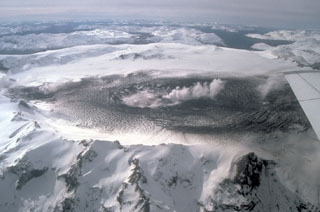Report on Cerro Hudson (Chile) — December 1991
Bulletin of the Global Volcanism Network, vol. 16, no. 12 (December 1991)
Managing Editor: Lindsay McClelland.
Cerro Hudson (Chile) Overflight reveals thick tephra and disruption of summit glaciers; many early-eruption lava flows
Please cite this report as:
Global Volcanism Program, 1991. Report on Cerro Hudson (Chile) (McClelland, L., ed.). Bulletin of the Global Volcanism Network, 16:12. Smithsonian Institution. https://doi.org/10.5479/si.GVP.BGVN199112-358057
Cerro Hudson
Chile
45.9°S, 72.97°W; summit elev. 1905 m
All times are local (unless otherwise noted)
The following, from J. Naranjo, describes observations made during a 21 January helicopter overflight.
Strong winds produced a continuous dense gray dusty haze along valleys and over mountains SE of the volcano. Weak fumarolic activity was visible at several summit vents and a small rockfall (landslide) on the caldera's N inner wall exposed altered rocks.
The N part of the 8-9 August fissure vent (16:8), 1.5 km long, ~200 m wide, and 100 m deep, showed sparsely distributed steam fumes. An ice dome, still present in the 8-9 August steam crater, was surrounded by beige-colored water. No fumarolic activity was observed.
The caldera glacier and the 12-15 August crater were covered by tephra, including bombs and coarse lapilli, estimated to be >10 m thick. Tilted steps were observed along the partially collapsed and intensively cracked concentric fractures around the central crater. Within the crater, glacier fragments and ponds of green and pale-brown water were visible. Weak gas emission from fumaroles (during warm weather) produced an intense sulfur odor. Another circular depression, ~ 300 m in diameter, had formed ~ 3 km E of the 12-15 August crater. Concentric cracks also developed around it, without accompanying collapse.
Lava flows on the NW flank of the caldera extended 1-1.5 km down the Ventisquero Huemules glacier from the rim fissure. Small flows were 2-3 m wide and 0.5 m thick; larger ones were up to 15 m wide and 1 m thick. These aa-like flows had developed conspicuous levees and central channels with curved ridges. They were partially covered by black ash from the 8-9 August eruption and had a dark reddish-brown color. Huemules glacier was intensively cracked and partially covered by layered lahar deposits and ash along erosional channels. Various green ponds were distributed along the glacier.
Geological Summary. The ice-filled, 10-km-wide caldera of Cerro Hudson volcano was not recognized until its first 20th-century eruption in 1971. It is the southernmost volcano in the Chilean Andes, related to subduction of the Nazca plate beneath the South American plate. The massive volcano covers an area of 300 km2. The compound caldera is drained through a breach on its NW rim, which has been the source of mudflows down the Río de Los Huemeles. Two cinder cones occur N of the volcano and others occupy the SW and SE flanks. This volcano has been the source of several major Holocene explosive eruptions. An eruption about 6,700 years ago was one of the largest known in the southern Andes during the Holocene; another eruption about 3,600 years ago also produced more than 10 km3 of tephra. An eruption in 1991 formed a new 800-m-wide crater in the SW portion of the caldera.
Information Contacts: J. Naranjo, SERNAGEOMIN, Santiago; P. Ippach, GEOMAR.

